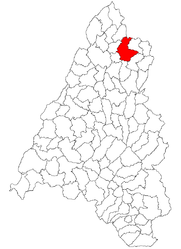Marghita
Marghita
Margitta | |
|---|---|
 | |
 Coat of arms | |
 Location within Bihor County | |
 Marghita Location in Romania | |
| Coordinates: 47°21′N 22°20′E / 47.350°N 22.333°ECoordinates: 47°21′N 22°20′E / 47.350°N 22.333°E | |
| Country | Romania |
| County | Bihor |
| Government | |
| • Mayor (2020–2024) | Marcel Sas-Adăscăliții[1] (Ind.) |
| Population (2011)[2] | 15,770 |
| Time zone | EET/EEST (UTC+2/+3) |
| Vehicle reg. | BH |
| Website | www |
Marghita (Romanian pronunciation: [marˈɡita]; Hungarian: Margitta [ˈmɒrɡittɒ]; Yiddish: מארגארעטין Margaretin) is a city in Bihor County, Romania. It administers two villages, Cheț (Magyarkéc) and Ghenetea (Genyéte), and is 56 km north-east of Oradea.
History[]
The name appears to be derived from the name "Margit" (Margaret), Saint Margaret the patron of a local church. The first time it was used in a document was in 1216. In the 14th century, it became a feudal holding of the Hungarian landlord.
In 1376 king Louis I of Hungary gave to Marghita the right of organizing a fair and it developed in the next centuries as a market town. There were several peasant revolts against the feudal system affecting Marghita in 1467 and 1514. At the beginning of the 16th century, it became along with parts of Bihor county and Hungary, an Ottoman province until towards the end of the 17th century.
In 1823, a great fire destroyed half of the buildings of Marghita. After the 1848 revolution, the local peasants were no longer serfs and manufacturing and industry began to develop.
Between 1920 (Treaty of Trianon) and 1940 (the Second Vienna Award) the town was part of Romania, after which it was again part of Hungary during much of the Second World War, until autumn 1944. In 1944, after German occupation, about 2,100 Jews of Marghita were sent to death, concentration and labor camps as part of the Holocaust, of which only about 450 survived. After 1947, with the Soviets imposing a Communist government in Romania, factories and land were nationalized. Over the course of the next few years, Marghita took part in the Romanian industrialization process.
Politics[]
The Marghita Municipal Council, elected in the 2012 local government elections, is made up of 17 councillors, with the following party composition:
| Party | Seats | Current Council | |||||||
|---|---|---|---|---|---|---|---|---|---|
| 41.18% | Democratic Alliance of Hungarians in Romania | 7 | |||||||
| 35.29% | National Liberal Party | 6 | |||||||
| 17.65% | Social Democratic Party | 3 | |||||||
| 5.88% | People's Party – Dan Diaconescu | 1 | |||||||
Population[]
| Year | Pop. | ±% |
|---|---|---|
| 1977 | 14,589 | — |
| 1992 | 19,071 | +30.7% |
| 2002 | 18,650 | −2.2% |
| 2011 | 15,134 | −18.9% |
| Source: Census data | ||
At the 2011 census, Marghita had a population of 15,134. According to the census, 51.7% of inhabitants are Romanians, 44.1% Hungarians, 3.5% Roma and 0.5% Slovaks.
Natives[]
- Attila Cseke (born 1973), Romanian lawyer and politician
- Nicolas Farkas (1890–1982), Austro-Hungarian-born cinematographer, screenwriter, and film director
- Violeta Friedman (1930–2000), Jewish Holocaust survivor turned author
- György Harag (1925–1985), theatre director and actor, worked primarily in Hungarian-language theatres in Romania
- George Pușcaș(born 1996), Romanian professional footballer
- Iosif Szökő (1930–2008), Hungarian-Romanian footballer
- Ioan Vulpescu (born 1976), Romanian politician
Sister cities[]
References[]
- ^ "Cine sunt primarii aleși ai municipiilor și orașelor din Bihor". ebihoreanul.ro. Retrieved 24 March 2021.
- ^ "Populaţia stabilă pe judeţe, municipii, oraşe şi localităti componenete la RPL_2011" (in Romanian). National Institute of Statistics. Retrieved 4 February 2014.
- ^ "Testvértelepülések". Retrieved 30 April 2014.
External links[]
| Wikimedia Commons has media related to Marghita. |
- Cities in Romania
- Populated places in Bihor County
- Localities in Crișana
- Place names of Hungarian origin in Romania

